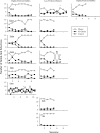A further analysis of the value of choice: controlling for illusory discriminative stimuli and evaluating the effects of less preferred items
- PMID: 20190933
- PMCID: PMC2741069
- DOI: 10.1901/jaba.2009.42-711
A further analysis of the value of choice: controlling for illusory discriminative stimuli and evaluating the effects of less preferred items
Abstract
We sought to address limitations of prior research that has isolated choice as an independent variable. Children's preferences for the opportunity to choose were evaluated in a concurrent-chains arrangement in which identical consequences were available in choice and no-choice conditions. Results demonstrated that preference for choice, in and of itself, was (a) evident in children, (b) not controlled by illusory discriminative stimuli such as the amount from which to choose, and (c) generally unaffected by less preferred and potentially unimportant consequences.
Keywords: choice; concurrent-chains arrangement; preference assessment; preschool children.
Figures
Similar articles
-
An evaluation of the value of choice with preschool children.J Appl Behav Anal. 2006 Spring;39(1):1-16. doi: 10.1901/jaba.2006.158-04. J Appl Behav Anal. 2006. PMID: 16602381 Free PMC article.
-
The effects of reinforcer pairing and fading on preschoolers' snack selections.J Appl Behav Anal. 2007 Winter;40(4):633-44. doi: 10.1901/jaba.2007.633-644. J Appl Behav Anal. 2007. PMID: 18189095 Free PMC article.
-
Determining preschoolers' preferences for choice-making opportunities: choice of task versus choice of consequence.J Appl Behav Anal. 2010 Fall;43(3):503-7. doi: 10.1901/jaba.2010.43-503. J Appl Behav Anal. 2010. PMID: 21358910 Free PMC article.
-
The influence of understanding and having choice on children's prosocial behavior.Curr Opin Psychol. 2018 Apr;20:107-110. doi: 10.1016/j.copsyc.2017.07.043. Epub 2017 Aug 14. Curr Opin Psychol. 2018. PMID: 28888948 Review.
-
Genetic and environmental determinants of children's food preferences.Br J Nutr. 2008 Feb;99 Suppl 1:S15-21. doi: 10.1017/S000711450889246X. Br J Nutr. 2008. PMID: 18257946 Review.
Cited by
-
Toward effective and preferred programming: a case for the objective measurement of social validity with recipients of behavior-change programs.Behav Anal Pract. 2010 Spring;3(1):13-21. doi: 10.1007/BF03391754. Behav Anal Pract. 2010. PMID: 22479668 Free PMC article.
-
Effects of differential reinforcement and rules with feedback on preference for choice and verbal reports.Anal Verbal Behav. 2012;28(1):31-57. doi: 10.1007/BF03393106. Anal Verbal Behav. 2012. PMID: 22754103 Free PMC article.
-
Choice versus no choice: Practical considerations for increasing choices.J Appl Behav Anal. 2025 Jan;58(1):100-117. doi: 10.1002/jaba.2920. Epub 2024 Nov 12. J Appl Behav Anal. 2025. PMID: 39532823 Free PMC article. Review.
-
Effects of a history of differential reinforcement on preference for choice.J Exp Anal Behav. 2011 Mar;95(2):189-202. doi: 10.1901/jeab.2011.95-189. J Exp Anal Behav. 2011. PMID: 21541125 Free PMC article.
-
They have a Voice; are we Listening?Behav Anal Pract. 2022 Apr 6;16(1):127-144. doi: 10.1007/s40617-022-00690-z. eCollection 2023 Mar. Behav Anal Pract. 2022. PMID: 37006422 Free PMC article. Review.
References
MeSH terms
LinkOut - more resources
Full Text Sources


